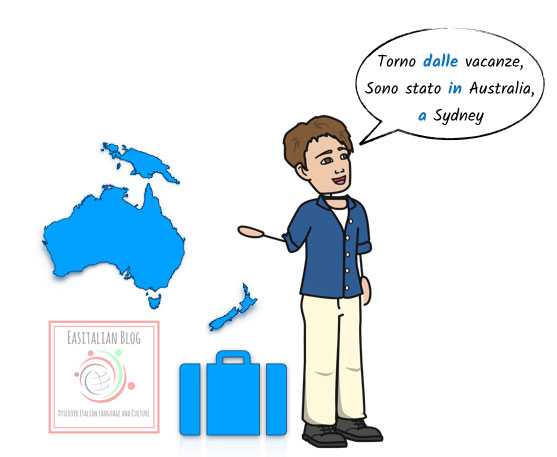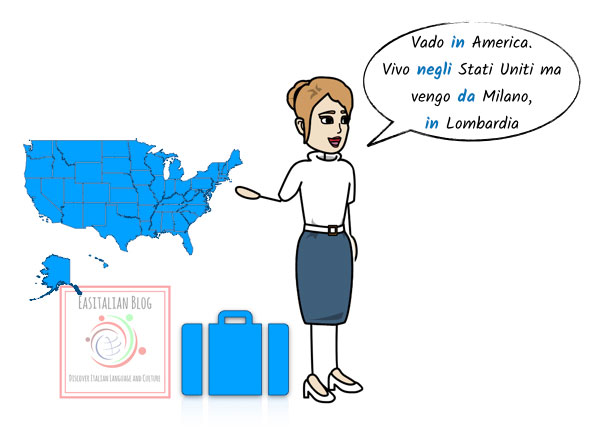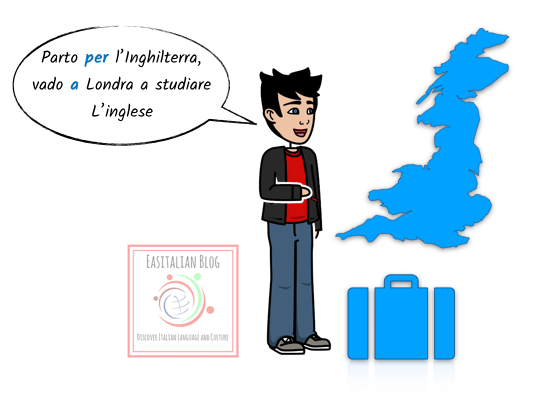The use of prepositions is an important element of the Italian language, particularly with verbs like andare, venire, and partire. In this post, we’ll look more closely at these verbs and how to use prepositions properly with them.
First, let’s go through the definitions of these verbs. Andare means “to go,” venire “to come,” and partire “to leave.” These verbs are often used in everyday conversations, and knowing how to use them correctly with prepositions is critical.
The preposition used with andare, venire, and partire depends on the context of the sentence. Prepositions have various meanings in different contexts and have a wide variety of uses, for this reason, is a good idea to learn prepositions bit by bit.
Here’s a list of the most often-used prepositions with these verbs:
- Andare (to go):
- A + city or country (e.g., vado a Roma, I’m going to Rome)
- In + mode of transportation (e.g., vado in macchina, I’m going by car)
- Da + person or place (e.g., vado da mio amico, I’m going to my friend’s place)
- Per + destination (e.g., vado per la biblioteca, I’m going to the library)
- Venire (to come):
- Da + place (e.g., vengo da casa, I’m coming from home)
- A + person (e.g., vengo a trovarti, I’m coming to see you)
- Partire (to leave):
- Da + place (e.g., parto da casa, I’m leaving from home)
- Per + destination (e.g., parto per il lavoro, I’m leaving for work)

Torno dalle vacanze, sono stato in vacanza in Australia, a Sydney

Vado in America. Vivo negli Stati Uniti ma vengo da Milano in Lombardia

Parto per l’Inghilterra, vado a Londra a studiare l’inglese
VERBO ANDARE
PREPOSIZIONE IN
Use this preposition with the names of nations, names of regions, names of continents.
ANDARE
IN
→ Italia, Spagna, Sicilia, America

Use the preposition IN also with the places in the cities (shops) / activities) and geographical places.
ANDARE
IN
→ città, centro, ufficio, banca, farmacia, vacanza, montagna
It also indicates the means of transport
ANDARE
IN
→ autobus, macchina, treno
PREPOSIZIONE A
Usa questa preposizione con i nomi di città. (Use this preposition with the names of cities.)
ANDARE
A
→ Roma, Parigi, Londra
Usa questa preposizione con i nomi dei luoghi in città (Use this preposition with the names of places in the city)
ANDARE
A
→ casa, letto, teatro, scuola, una festa
Usa questa preposizione con i nomi dei pasti (Use this preposition with the names of the meals)
ANDARE
A
→ pranzo, cena, colazione
Usa questa preposizione con i verbi all’infinito che seguono il verbo andare. (Use this preposition with the infinitive verbs that follow the verb to go)
ANDARE
A
→ studiare, fare spese, ballare, lavare
Usa questa preposizione per indicare l’azione di camminare. (Use this preposition to indicate the action of walking)
ANDARE
A
→ piedi
Usa questa preposizione con i punti cardinali. (Use this preposition with the cardinal directions.)
ANDARE
A
→ sud, est, nord, est
PREPOSIZIONE ARTICOLATA AL
Usa questa preposizione con i nomi di luoghi in città e nomi geografici. (Use this preposition with the names of places in the city and geographical names).
ANDARE
AL
→ cinema, mare, bar, ristorante, primo piano
PREPOSIZIONE DA
Per indicare la persona dove qualcuno va – o si trova. (to indicate the person where someone goes – or stay)
ANDARE
DA
→ un amico, Antonio, il fioraio
Verbi VIVERE e ABITARE usano le stesse preposizioni.
VERBO VENIRE
PREPOSIZIONE IN
Usa questa preposizione con i nomi di nazioni, nomi di regioni, nomi di continenti. (Use this preposition with the names of nations, names of regions, names of continents.)
VENIRE
IN
→ Italia, Germania, aereo, treno
PREPOSIZIONE A
Usa questa preposizione con i nomi di città, con il luoghi della città. (Use this preposition with the names of cities, with the places in the city)
VENIRE
A
→ Pisa, casa, teatro
PREPOSIZIONE DA
Indica il posto di partenza, di origine, il luogo da cui qualcuno parte o viene. (It indicates the place of departure, of origin, the place from which someone leaves or comes.)
VENIRE
DA
→ Siena, Napoli, Nicola, te, solo
La preposizione DA è articolata quando è seguita da nomi di continenti, nazioni e regioni. – dall’Italia, dalla Francia) The DA preposition is “articolata” when it is followed by names of continents, nations and regions. – dall’Italia, dalla Francia)
VERBO PARTIRE
PREPOSIZIONE IN
per indicare il mezzo di trasporto usato (To indicate the means of transport used)
PARTIRE
IN
→ aereo, macchina, treno, autobus, ottobre
PREPOSIZIONE PER
per indicare la destinazione di un viaggio (to indicate the destination of a journey)
PARTIRE
PER
→ Ancona, Barcellona
→ l’Italia, la Francia, gli Stati Uniti
PREPOSIZIONE DA
Per indicare il luogo di origine di un viaggio (to indicate the place of origin of a journey)
PARTIRE
DA
→ Torino, Perugia, Barcellona
VERBO ESSERE
PREPOSIZIONE DI
Indica la città in cui si vive. (Indicates the city where you live.)
ESSERE
DI
→ Milano, Roma
PREPOSIZIONE A
Indica la città in cui qualcuno si trova (This specifies the city where someone is)
ESSERE
A
→ Roma, Parigi, Londra
PREPOSIZIONE IN
Indica il posto in cui qualcuno si trova (It indicates the place where someone is)
ESSERE
IN
→ Italia, Spagna, Sicilia, America
As you can see from the examples, the prepositions used with these verbs help clarify the context and meaning of the sentence.
Prepositions are essential in the Italian language, especially when using verbs like andare, venire, and partire. By understanding how to use prepositions correctly with these verbs, you can communicate more effectively in Italian and better understand the meaning of sentences. So, take some time to practice using prepositions with these verbs, and you’ll be well on your way to mastering Italian!

What’s next?
You might want to keep learning Italian online with these free resources:










Leave a Reply